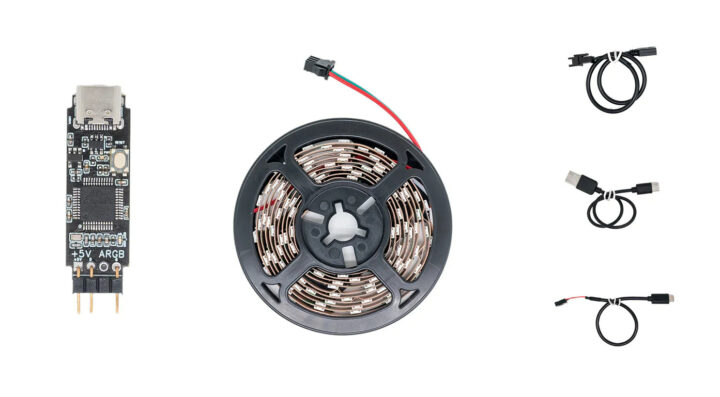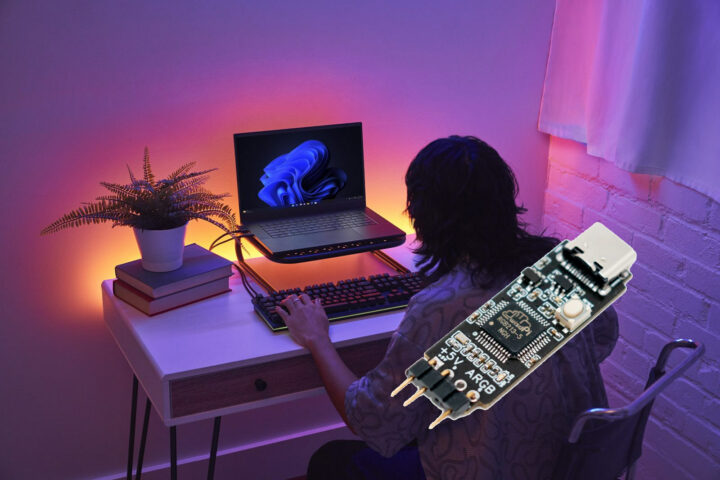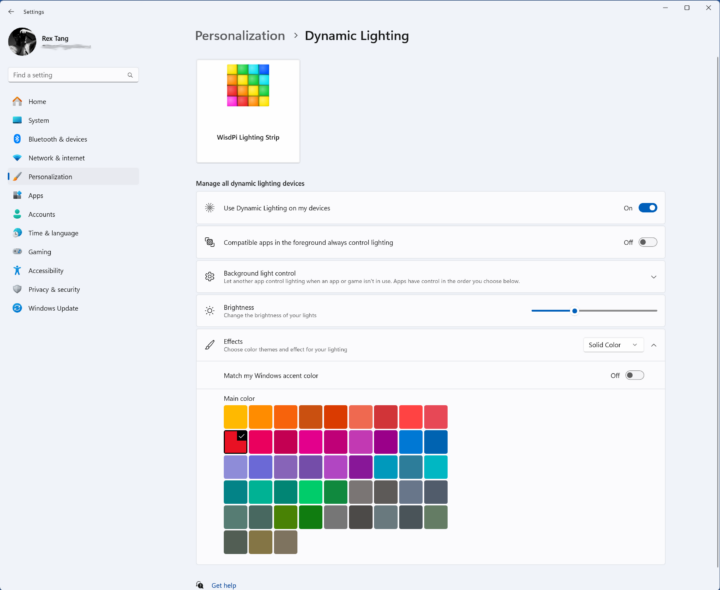WisdPi WP-DLC01 dynamic lighting controller is a small USB board that can drive RGB LED strips and supports the Dynamic Lighting feature just introduced in the latest Windows 11 23H2 release.
The board comes with a WisdPi RGB213-5 chip, a button, a USB-C port for control, and a 3-pin header designed to connect an ARGB LED strip which the user can place inside a PC or along a desk or table to personalize the user experience beyond the screen. Right now this works in Windows 11 23H2, but as we’ll see further below it should (eventually) work with other operating systems.
The first step is to connect the controller either externally via a USB-C to USB-A/C cable or internally using the 15cm USB 2.0 internal motherboard header to USB Type-C cable provided with the WP-DLC01 board by default. WisdPi also offers a full kit that adds a 1-meter USB 2.0 Type-A to Type-C cable and a 2-meter RGB LED strip with 120 WS2812B LEDs to connect to the 3-pin/4-pin RGB header.

Once the hardware installation is done, you’ll need to configure Dynamic Lighting in Windows 11 Settings->Personalisation. The interface will allow you to select a solid color, change the effects to breathing., rainbow, or others, or match the colors of your Windows desktop, as well as adjust brightness. More details can be found in the Wiki.
But how is Dynamic Lighting implemented exactly? It turns out it’s based on USB HID’s Lighting and Illumination standard and in particular LampArray according to the developer’s documentatoin on GitHub. This standard works with LEDs in keyboards and mice, but also with RGB LED strips.
Since Dynamic Lighting is based on a USB standard, it should also work in Linux either now or when it’s implemented. 0x59 is the Page ID for the Lighting and Illumination page, and while I can’t find any reference to it in the HID Linux kernel documentation, it’s present in the hid-tools utility, and one user on Reddit mentions that OpenRGB should already handle this USB standard, so it looks like it might already work in Linux and macOS. The Raspberry Pi SBC is another candidate, but it looks like you’d need to build OpenRGB from source since no Arm64 Linux binary is provided.
WisdPi WP-DLC01 dynamic lighting controller can be purchased for $9.99 plus shipping, or you can get a full kit with a 2-meter RGB LED strip for $19.99. Other companies also make use of the new Dynamic Lighting features in Windows 11 with devices such as ASUS ROG keyboard and a ROG mice, MSI CreatorPro Z16/Z17, and upcoming products from Logitech, Acer, and others. Microsoft’s developer documentation also explains you can create your own controller with an Arduino board or Adafruit Macropad.

Jean-Luc started CNX Software in 2010 as a part-time endeavor, before quitting his job as a software engineering manager, and starting to write daily news, and reviews full time later in 2011.
Support CNX Software! Donate via cryptocurrencies, become a Patron on Patreon, or purchase goods on Amazon or Aliexpress






The dude in the first photo is emblematic for the product ! :))
Hmm, I wonder how hard it would be to impliment this on a common microcontroller.
I strongly doubt the chip on this is some unique chip made by this company. Have they given any hint what the chip really is?
There’s so many possiblities, it would be hard to figure that out with a lot of knowledge and a few cut open chips. Just reimplement it–it’s all open standards.
ESP32C3 has everything you need and modules are $1.50. It has the USB and RGB LED controller. You get wifi and BLE too.
I think the context was reverse engineering what chip they were already using.